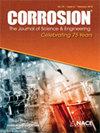Lithium Carbonate and Oxalate Salts as Corrosion Inhibitors for Magnesium Alloy AZ31 B in NaCl Solution
IF 1.3
4区 材料科学
Q4 MATERIALS SCIENCE, MULTIDISCIPLINARY
引用次数: 0
Abstract
The corrosion inhibition effectiveness of dissolved Li2CO3 and Li2C2O4 was studied for Mg alloy AZ31 B in 0.1 M NaCl solution. The electrochemical and corrosion inhibition properties of Li salts were studied using potentiodynamic polarization (PDP), linear polarization resistance (LPR), electrochemical impedance spectroscopy (EIS), and H2 evolution measurement methods. The corrosion inhibition efficiency as a function of immersion time was also investigated. The morphology and chemical composition of AZ31 B surfaces after 24 h immersion in 0.1 M NaCl with and without the addition of dissolved Li salts revealed considerable differences in corrosion properties. The role of Li+ ions, CO32- ions, and C2O42- on corrosion inhibition of AZ31 B was focused and their role in the corrosion inhibition was discussed. Li2CO3 had better corrosion inhibition efficiency compared to Li2C2O4 in 0.1 M NaCl solution at ambient temperature. The optimum concentration of Li2CO3 was 50 mM to provide the highest corrosion inhibition efficiency of 96.75 %, while the optimum concentration and inhibition efficiency for Li2C2O4 were 3 mM and 82.84 % respectively. Surface characterization of the Li2CO3 inhibited AZ31 B revealed that the enhanced corrosion protection was due to the formation of a protective layer mainly composed of MgCO3. Corrosion studies over time showed that Li2CO3 could effectively provide corrosion protection for 48 h, while Li2C2O4 became ineffective after 12 h of immersion in 0.1 M NaCl.碳酸锂和草酸盐作为氯化钠溶液中镁合金 AZ31 B 的缓蚀剂
研究了溶解的 Li2CO3 和 Li2C2O4 在 0.1 M NaCl 溶液中对镁合金 AZ31 B 的缓蚀效果。采用电位极化(PDP)、线性极化电阻(LPR)、电化学阻抗谱(EIS)和 H2 演化测量方法研究了锂盐的电化学和缓蚀特性。此外,还研究了腐蚀抑制效率与浸泡时间的函数关系。在加入和未加入溶解锂盐的 0.1 M NaCl 溶液中浸泡 24 小时后,AZ31 B 表面的形态和化学成分显示其腐蚀性能存在很大差异。重点研究了 Li+ 离子、CO32- 离子和 C2O42- 对 AZ31 B 的缓蚀作用,并讨论了它们在缓蚀中的作用。在常温下的 0.1 M NaCl 溶液中,与 Li2C2O4 相比,Li2CO3 的缓蚀效率更高。Li2CO3 的最佳浓度为 50 mM,缓蚀效率最高,达到 96.75%,而 Li2C2O4 的最佳浓度和缓蚀效率分别为 3 mM 和 82.84%。Li2CO3 抑制的 AZ31 B 的表面表征显示,腐蚀保护的增强是由于形成了主要由 MgCO3 组成的保护层。随时间变化的腐蚀研究表明,Li2CO3 可以在 48 小时内有效地提供腐蚀保护,而 Li2C2O4 在 0.1 M NaCl 中浸泡 12 小时后就失效了。
本文章由计算机程序翻译,如有差异,请以英文原文为准。
求助全文
约1分钟内获得全文
求助全文
来源期刊

Corrosion
MATERIALS SCIENCE, MULTIDISCIPLINARY-METALLURGY & METALLURGICAL ENGINEERING
CiteScore
2.80
自引率
12.50%
发文量
97
审稿时长
3 months
期刊介绍:
CORROSION is the premier research journal featuring peer-reviewed technical articles from the world’s top researchers and provides a permanent record of progress in the science and technology of corrosion prevention and control. The scope of the journal includes the latest developments in areas of corrosion metallurgy, mechanisms, predictors, cracking (sulfide stress, stress corrosion, hydrogen-induced), passivation, and CO2 corrosion.
70+ years and over 7,100 peer-reviewed articles with advances in corrosion science and engineering have been published in CORROSION. The journal publishes seven article types – original articles, invited critical reviews, technical notes, corrosion communications fast-tracked for rapid publication, special research topic issues, research letters of yearly annual conference student poster sessions, and scientific investigations of field corrosion processes. CORROSION, the Journal of Science and Engineering, serves as an important communication platform for academics, researchers, technical libraries, and universities.
Articles considered for CORROSION should have significant permanent value and should accomplish at least one of the following objectives:
• Contribute awareness of corrosion phenomena,
• Advance understanding of fundamental process, and/or
• Further the knowledge of techniques and practices used to reduce corrosion.
 求助内容:
求助内容: 应助结果提醒方式:
应助结果提醒方式:


